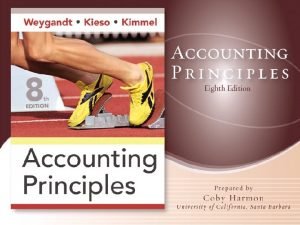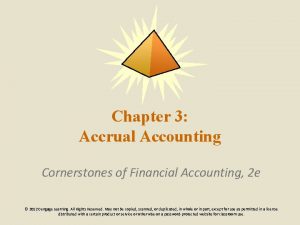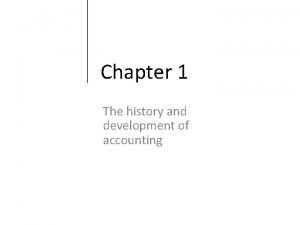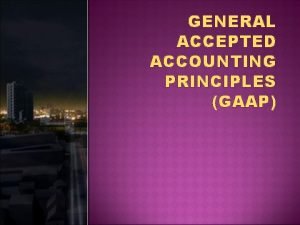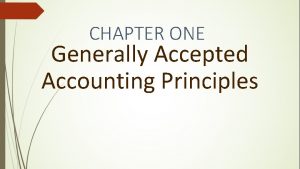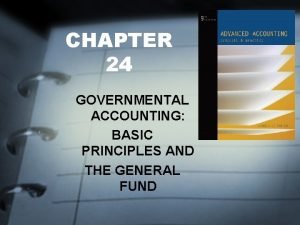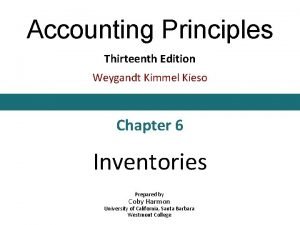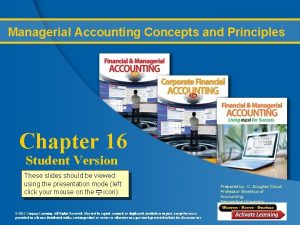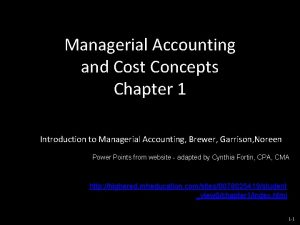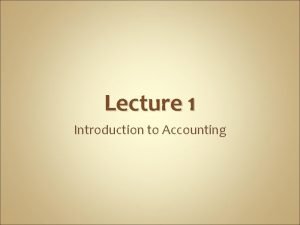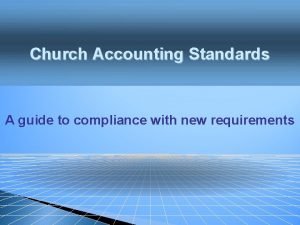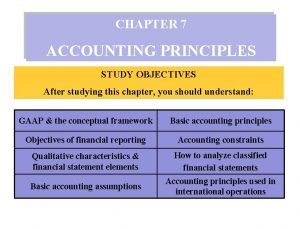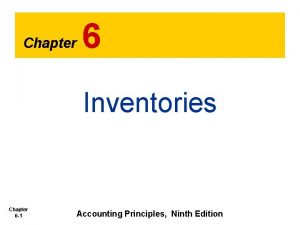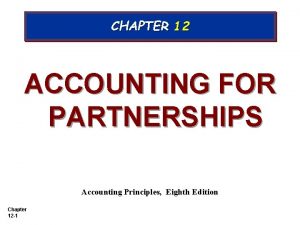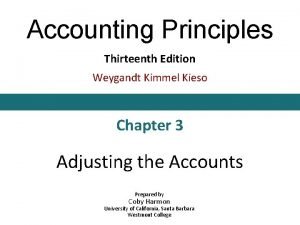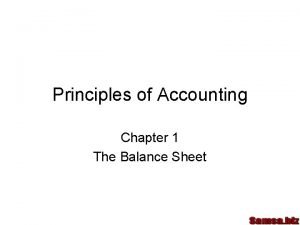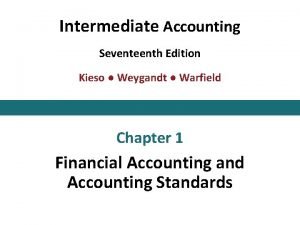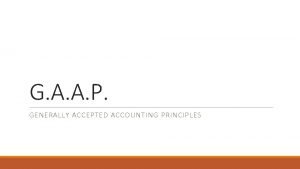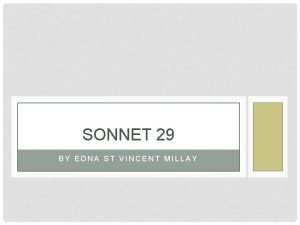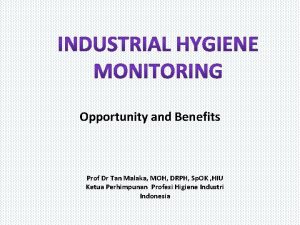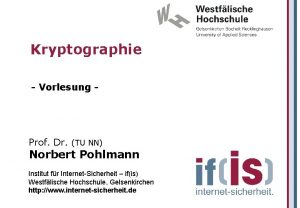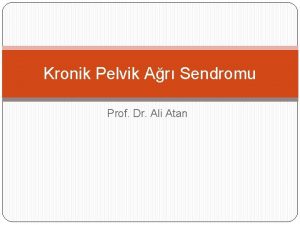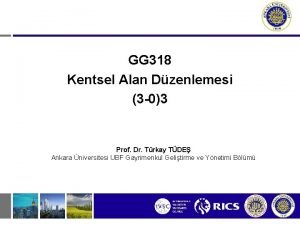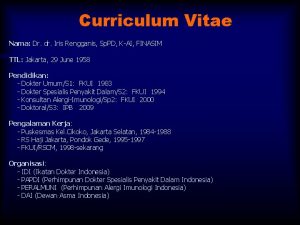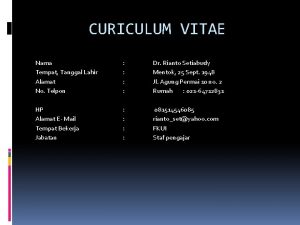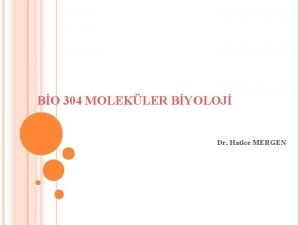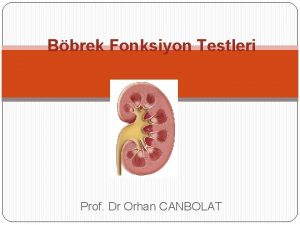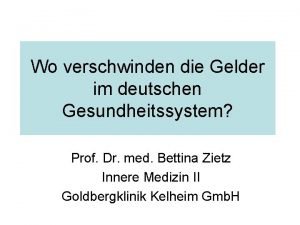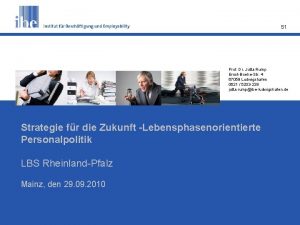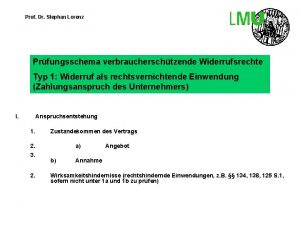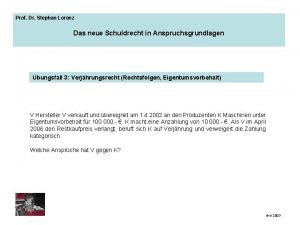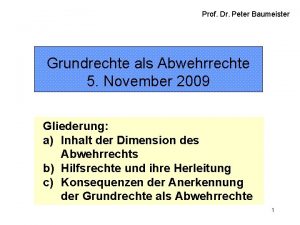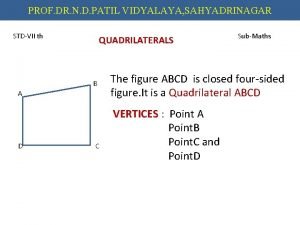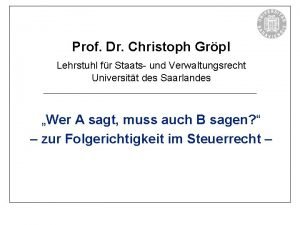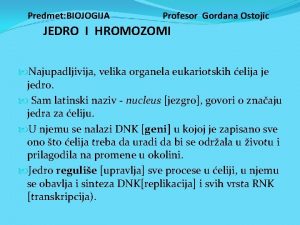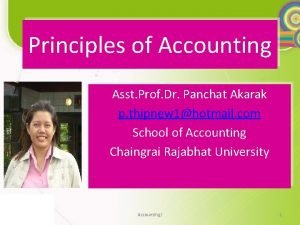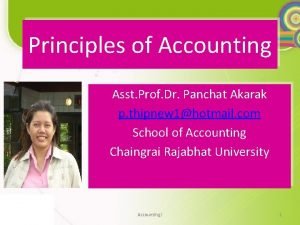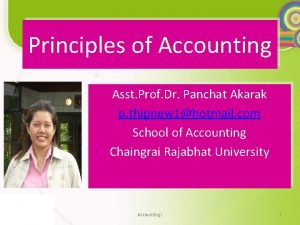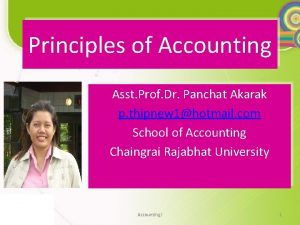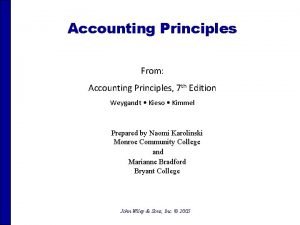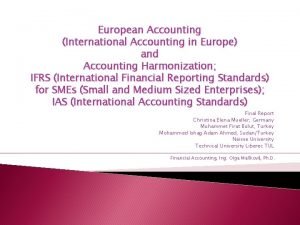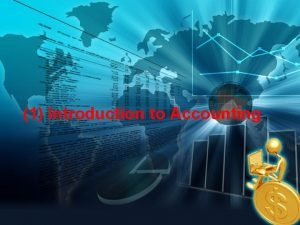Principles of Accounting II Asst Prof Dr Panchat











































































































































- Slides: 139

Principles of Accounting II Asst. Prof. Dr. Panchat Akarak p. thipnew 1@hotmail. com School of Accounting Chiang Rai Rajabhat University Principles of Accounting II 1

Accounting Systems and Special Journals Outline 1. Control Accounts and Subsidiary Ledgers 2. Special Journals 3. Alternative Methods of Processing data Principles of Accounting II 2

Accounting Systems and Special Journals Learning Objectives 1. Describe the relationship between subsidiary accounts in subsidiary ledgers and control accounts in the general ledger. 2. Describe the relationship between special journals and the general journal. 3. Describe computer applications in business. Principles of Accounting II 3

1. The Processing of Data Manual System 1. An accounting system can be defined as a set of records such as; -Journals, (สมดรายวน ) -Ledgers, (บญชแยกประเภท ) -Trial balances (งบทดลอง) -Work sheets, and (กระดาษทำการ ) -Financial reports, (รายงานทางการเงน /งบการเงน ) plus the procedures and equipment regularly used to process business transactions Principles of Accounting II 4

1. The Processing of Data Manual System 2. For accounting systems to be effective, they should: a. Provide for the efficient processing of data at the least cost, The cost of the system should be equal to or less than the benefits received. b. Ensure a high degree of accuracy. c. Provide for internal control to prevent theft or fraud. d. Provide for the growth of a business. Principles of Accounting II 5

2. Control Accounts and Subsidiary Ledgers • The method of initially recording and summarizing transaction data is influenced by the nature of the transactions, the materiality of the amounts, the means available for processing the data, and the reports desired. a. Sometimes a company need general information and at other times it needs specific information b. In order to provide for both types of information, control accounts are maintained to provide balance sheet data and subsidiary accounts are maintained to provide specific information relating to customers and creditors. Principles of Accounting II 6

3. Control Accounts • A Control account is an account in the general ledger that shows the total balance of all the subsidiary accounts related to it. general ledger…. No…. Date Description Page No. Dr. Date Description amount Principles of Accounting II Page No. Cr. amount 7

4. Subsidiary Ledger Accounts • Subsidiary ledger accounts show the details supporting the related general ledger control account balance. Principles of Accounting II 8

5. Subsidiary Ledger • A subsidiary ledger is a group of related accounts showing the details of the balance of the general ledger control account. a. A subsidiary ledger relives the general ledger of a mass of detail and shortens the general ledger trial balance. b. A subsidiary ledger promotes a division of labor. Principles of Accounting II 9

5. Subsidiary Ledger Accounts Receivable name. . . . (1). . . AC. Date Description Dr. Page (2) (3) (4) (5) Principles of Accounting II Page). . . 2. . . ( Cr. (6) Balance (7) 10

5. Subsidiary Ledger Accounts Payable name. . . . (1). . . AC. Date Description Dr. Page (2) (3) (4) (5) Principles of Accounting II Page). . . 2. . . ( Cr. (6) Balance (7) 11

6. Special Journals • Special Journals have been designed to systematize the original recording of major recurring transactions. a. The general journal is used for all transactions that cannot be entered readily in one of the special journals. b. Each of the special journals is a record of original entry which contains the data which will be posted to ledger accounts. Principles of Accounting II 12

7. Advantages of Special Journals • Several advantages are obtained from the use of special journals. a. Time is saved in journalizing. b. Time is saved in posting. c. Detail is eliminated from the general journal. d. Division of labor is promoted. e. Management analysis is aided. Principles of Accounting II 13

8. Type of Special Journals • Sales Journal (สมดรายวนขาย ) • Sales Return Journal (สมดรายวนรบคน ) • Cash Receipt Journal (สมดรายวนรบเงน ) • Purchases Journal (สมดรายวนซอ • Purchases Return Journal (สมดรายวนสงคน ) Principles of Accounting II ) 14

8. Type of Special Journals • • Sales Journal -Sale on account Sales Return Journal -S/R on account Cash Receipt Journal - Cash Receipt Purchases Journal -Purchases on account Purchases Return Journal -P/R on account Cash Disbursements Journal -Cash paid General Journal -general recorded Principles of Accounting II 15

9. Sales Journal Recognition entry; Sale on account Dr. Accounts Receivable (103) Cr. Sale (401) Vat of Sale (203) Principles of Accounting II xx xx xx 16

9. Sales Journal Recognition entry; Sale on account การบนทกบญช ขายสนคาเปนเงนเชอ Dr. ลกหนการคา (103) xx Cr. ขายสนคา (401) xx Principles of Accounting II 17

9. Sales Journal) 1( Date (3) Page) 2( Dr. Cr. Voucher Accounts Credit Ac. Receivable term No Revenues No. (4) (5) (6) (7) Principles of Accounting II (8) VAT (9) Accounts Receivable (10) 18


9. Sales Journal • The sales journal should be used to record all sales of merchandise on account. a. The simplest form has only one money column entitled Accounts Receivable Dr. and Sales Cr. b. Columns are included for the date, name of the customer, and invoice number. c. A Sales Cr. Column can be provided for each department, if needed. Principles of Accounting II 20

9. Sales Journal d. The posting of sales involves entering the total of the Sales Cr. Column as a credit to the general ledger Sales account. e. The total of the Accounts Receivable Dr. column is posted as a debit to the Accounts Receivable account in the general ledger. Principles of Accounting II 21

9. Sales Journal f. The individual amounts in the Accounts Receivable Dr. column are posted to each individual customer’s account in the subsidiary ledger. g. Some companies use sales invoices as their sales journal by entering the amount of each sales invoice directly in the subsidiary ledger account of the customer. At the end of the month the total of the sales invoices is debited to Accounts Receivable and credited to Sales in the general journal. Principles of Accounting II 22





ผานรายการไปบญชแยกปร ะเภททวไป ขายสนคา Date Description Page No. Dr. Date Description amount 25 x 1 ส. ค. 31 สมดรายวน ขาย ส. ค. 1 4 1 8 2 7 3 8 -01 8 -02 8 -03 8 -04 8 -05 รานสว ทย รานสธร รม รานสว ทย 2/10 , 8, 000 n/45 11, 400 7, 500 3/15, 4, 800 n/30 3, 200 1 , 10/ n/30 Principles of Accounting II 34, 900 - Page No. Cr. amount ข. 1 34, 900 - 560 798 525 336 224 - 2, 443 - 8, 560 12, 19 8 8, 025 5, 136 3, 424 27 37, 34 -

ผานรายการไปบญชแยกปร ะเภททวไป ภาษขาย Date Description Page No. Dr. Date Description amount 25 x 1 ส. ค. 31 สมดรายวน ขาย ส. ค. 1 4 1 8 2 7 3 0 8 -01 8 -02 8 -03 8 -04 8 -05 รานสว ทย รานสธร รม รานสว ทย รานสธ 2/10 , 8, 000 n/45 11, 400 7, 500 3/15, 4, 800 n/30 3, 200 1 , 10/ n/30 34, 900 Principles of Accounting II - Page No. Cr. amount ข. 1 2, 443 - 560 798 525 336 224 - 2, 443 - 8, 560 12, 19 8 8, 025 5, 136 3, 424 37, 34 28 3 - N

ผานรายการไปบญชแยกปร ะเภททวไป ลกหนการคา Date Description 25 x 1 ส. ค. 31 สมดรายวนข าย ส. ค. 1 4 1 8 2 7 3 0 8 -01 8 -02 8 -03 8 -04 8 -05 รานสว ทย รานสธร รม รานสว ทย รานสธ Page No. Dr. Date Description amount ข. 1 37, 343 - 2/10 , 8, 000 n/45 11, 400 7, 500 3/15, 4, 800 n/30 3, 200 1 , 10/ n/30 34, 900 Principles of Accounting II - Page No. 560 798 525 336 224 - 2, 443 - Cr. amount 8, 560 12, 19 8 8, 025 5, 136 3, 424 37, 34 29 3 -

10. Sales Return Journal • When, Sales Returns on account Dr. Sales Returns (402) xx Vat of Sale (203) xx Cr. Accounts Receivable (103) xx Principles of Accounting II 30

10. Sales Return Journal • When, Sales Returns on account • การบนทกบญช รบคนสนคาจากการขายเช อ Dr. รบคนสนคา (402) xx Principles of Accounting II 31

10. Sales Return Journal Page 1 Date No. Cr. Note Accounts Receivable AC. No. (1) (2) (3) (4) Principles of Accounting II Dr. Sale Returns VAT (5) (6) Cr. Accounts Receivable (7) 32











11. Cash Receipt Journal • When, Cash Receipt Dr. Cash (101) xx Cash in Bank (102) xx Sale Discounts (403) xx Cr. Accounts Receivable (103) or Dr. Cash (101) xx Cash in Bank (102) xx Cr. Sale (401) Other Revenues (404) Loan (204) Investment (105) Principles of Accounting II xx xx xx 43


11. Cash Receipts Journal) 1 Date Ac Voucher name NO. Cr. Dr. Discretion Cash bank Accounts Receivable Sale Discounts (4) (5) (6) (7) (8) (9) (10 1) (10 2) (403 ) Cr. Other Account Sale VAT (10) (11) (12) (13) (10 3) (40 1) (203 ) (3) (Page (2) Principles of Accounting II Amount Ac. no amount (14) (15) 45


11. Cash Receipt Journal • The cash receipts journal is used to record all receipts of cash, including cash sales. a. Typically, the following columns, will be provided: Cash Dr. , Sales Discounts Dr. , Date, Description, Sales Cr. , Accounts Receivable Cr. , Other Accounts Cr. b. The Cash Dr. , Sales Discounts Dr. , Sales Cr. , and Accounts Receivable Cr. Column totals are posted to those accounts in the general ledger. Principles of Accounting II 47

11. Cash Receipt Journal c. The individual amounts in the Accounts Receivable Cr. Column are posted to each individual customer’s account in the subsidiary ledger. d. The amounts appearing in the Other Accounts Cr. Column are posted in the general ledger to the accounts indicated; the column total is not posted. Principles of Accounting II 48

12. Combined Sales and Cash Receipts Journal • It is possible to combine the sales and cash receipts journals. A. Total sales can then be posted as one amount rather than two. B. But the number of persons who can work with the data is restricted. Principles of Accounting II 49

13. Purchases Journal • Recognition entry; Purchases on account Dr. Purchases (501) Vat of Purchases (104) Cr. Accounts Payable (201) Principles of Accounting II xx xx xx 50

13. Purchases Journal • Recognition entry; Purchases on account การบนทกบญช : ซอสนคาเปนเงนเชอ Dr. ซอสนคา (501) xx ภาษซอ (104) xx Cr. เจาหนการคา (201) xx Principles of Accounting II 51

13. Purchases Journal )1( Date Invoice No. Name Accounts Payable (3) (4) (5) Page) 2( Dr. Credit Ac. term No. Purchase (6) (7) Principles of Accounting II Cr. VAT (8) (9) (501) (104) Accounts Payable (10) (201) 52


13. Purchases Journal • The purchases journal is used to record all purchases made on account. a. The simplest form has only one money column entitled Purchases Dr. , Accounts Payable Cr. b. Columns are included for the date, terms of sale, invoice number, and name of creditor. c. A purchases Dr. column can be provided for each department, if needed. Principles of Accounting II 54

13. Purchases Journal d. The total of the Purchases Dr. column is posted as a debit to the general ledger Purchases account. e. The total of the Accounts Payable Cr. Column is posted as a credit to the general ledger Accounts Payable account. f. The individual amounts in the Accounts Payable Cr. Column are posted to each individual creditor’s account in the subsidiary ledger. Principles of Accounting II 55








14. Purchases Return Journal • When, Purchases returns on account Dr. Accounts Payable (201) xx Cr. Purchases Returns (502) xx Vat of Purchases (104) xx Principles of Accounting II 63


14. Purchases Return Journal Purchases Return Journal) 1( Date (3) Debit Note No (4) Name Accounts Payable (5) Page )2. . . ( Cr. Dr. AC. No. Purchases Returns VAT Accounts Payable (6) (7) (8) ( 9) (502) (104) (201) Principles of Accounting II 65









15. Cash Disbursements Journal • When, paid Cash Dr. Accounts Payable Cr. Cash in Bank Purchases Discounts (201) (101) (102) (503) xx (505) (106) (101) (102) xx xx xx Or Dr. Expense/Voucher Investment Fixed Assets Cr. Cash in Bank Principles of Accounting II xx xx 74


15. Cash Disbursement Journal )1 Date (3) Voucher No. (4) Account Name Description Dr. (5) (6) Cr. Cash Bank Accounts Payable Purchases Discount (7) (8) (9) (101) (102) (503) amount Page (2) ( Dr. Purchases VAT (10) (11) (12) (13) (201) (501) (104) Principles of Accounting II Other Accounts AC. No. amount (14) (15) 76


15. Cash Disbursements Journal • The cash disbursements journal is used to record all disbursements of cash. a. Typically, the following columns will be provided: Accounts Payable Dr. , Supplies Expense Dr. , Other Accounts Dr. , Date, Description, Check Number, Cash Cr. , Purchases Discounts Cr. b. The Accounts Payable Dr. , Supplies Expense Dr. , Purchase Discounts Cr. , and Cash Cr. Column totals are posted to those accounts in the general ledger. Principles of Accounting II 78

15. Cash Disbursements Journal c. The individual accounts in the Accounts Payable Dr. column are posted to each individual creditor’s accounts in the subsidiary ledger. d. The amounts appearing in the other Accounts Dr. column are posted in the general ledger to the accounts indicated; the column total is not posted. Principles of Accounting II 79

16. Combined Purchases and Cash Disbursements Journal • The purchases and the cash disbursements journal can be combined; however, this limits the number of people who can work with the journals at any one time. Principles of Accounting II 80

General Journal • Transactions that do not belong in a special journal are entered in the general journal. Principles of Accounting II 81

Alternative Methods of Processing Data • Accountants have a wide range of equipment that can be used in accounting systems to process data, including the following: a. Manual systems b. Bookkeeping machine system c. Microcomputers and Minicomputers d. Service bureaus e. Time-sharing terminal. f. Mainframe In-House Computer Principles of Accounting II 82

Manual System • Small businesses often use a handposted system in which the accounting function is handled by the accountant and possible one or two clerks. Principles of Accounting II 83

Bookkeeping Machine System • A bookkeeping machine system is usually set up so that recurring transactions are recorded on the bookkeeping machines. Principles of Accounting II 84

Minicomputers and Microcomputers • With the lowering of computer prices, may small and medium-sized businesses are replacing their manual systems with microcomputers and minicomputers. a. Microcomputers are smaller than minicomputers. b. Cost is often the distinction between a microcomputer and a minicomputer. Principles of Accounting II 85

Time-Sharing Terminal. • Time sharing occurs when several users Utilize the same host computer to process data. Principles of Accounting II 86

Mainframe in-house Computer • The purchase of an in-house computer is often justified if the volume of transaction is very large. Principles of Accounting II 87

Accounting Software • Express Accounting 28% • • • SAP* • • ACCPAC • • ORACLE* • • EASY- ACC. • • FORMULA SUPER GL Clip Accounting My Account Auto Flight Pattani Freeware Imoneys Account ERP Impress Professional • QUICK BOOKs • BUSINESS • SCALA *เปนโปรแกรมเหมาะกบกจการขนา Principles of Accounting II 88



















































The End Thank you for your Attention Q&A Principles of Accounting II 139
 Financial accounting chapter 1
Financial accounting chapter 1 Conclusion of computerised accounting system
Conclusion of computerised accounting system Accounting period concept in accounting
Accounting period concept in accounting Role and responsibility of management accountant ppt
Role and responsibility of management accountant ppt Accounting for pharmacies
Accounting for pharmacies Inventory costing methods
Inventory costing methods Accrual accounting principles
Accrual accounting principles Accounting principles second canadian edition
Accounting principles second canadian edition Accounting principles second canadian edition
Accounting principles second canadian edition Accounting principles second canadian edition
Accounting principles second canadian edition Accounting principles and policies
Accounting principles and policies Chapter 4 accrual accounting concepts
Chapter 4 accrual accounting concepts Accounting conventions
Accounting conventions Management contribution phase
Management contribution phase General accepted
General accepted Manual accounting information system
Manual accounting information system 6 principles of accounting
6 principles of accounting Government accounting basics
Government accounting basics Accounting principles 13th edition
Accounting principles 13th edition Accounting principles second canadian edition
Accounting principles second canadian edition Cost benefit constraint example
Cost benefit constraint example What is accounting constraints
What is accounting constraints Accounting principles and concepts
Accounting principles and concepts Chapter 1 managerial accounting and cost concepts
Chapter 1 managerial accounting and cost concepts 3 basic accounting concepts
3 basic accounting concepts Cost concept
Cost concept Church accounting rules
Church accounting rules 7 accounting principles
7 accounting principles Chapter 6 inventories
Chapter 6 inventories 12 accounting principles
12 accounting principles Accounting principles 13th edition
Accounting principles 13th edition Principles of accounting chapter 2
Principles of accounting chapter 2 Gaap principles
Gaap principles The materiality principle
The materiality principle Prof. dr. marcus eckert
Prof. dr. marcus eckert Agamenonquimica
Agamenonquimica Prof david toback
Prof david toback What is this in english
What is this in english Prof suganda tanuwidjaja
Prof suganda tanuwidjaja Prof david kipping
Prof david kipping Tracce svolte prove scritte tfa sostegno già svolte pdf
Tracce svolte prove scritte tfa sostegno già svolte pdf Texte argumentatif plan simple
Texte argumentatif plan simple Rodzaj literacki syzyfowych prac
Rodzaj literacki syzyfowych prac Cua study abroad
Cua study abroad When was sonnet 29 written
When was sonnet 29 written Prof maya devita
Prof maya devita Nadp redüktaz
Nadp redüktaz Obsatar sinaga
Obsatar sinaga Pem dereceleri
Pem dereceleri Foundation in general science in ireland
Foundation in general science in ireland Prof paolo bellioni
Prof paolo bellioni Ramlimusa com
Ramlimusa com Prof aris
Prof aris Prof agamenon roberto
Prof agamenon roberto Bilgin arda
Bilgin arda Prof dr halil ak
Prof dr halil ak Prof jusak nugraha
Prof jusak nugraha Umi narimawati
Umi narimawati Prof dr hayri ülgen
Prof dr hayri ülgen Prof tan malaka
Prof tan malaka Transpilorik beslenme
Transpilorik beslenme Prof. dr. fevziye toros
Prof. dr. fevziye toros Ledo vaccaro machado
Ledo vaccaro machado Prof tomasz targowski
Prof tomasz targowski Prof dr yahya büyükaşık
Prof dr yahya büyükaşık Prof msc
Prof msc Lemod solu
Lemod solu Prof. dr. jan papy
Prof. dr. jan papy Prof dr mehmet yılmazer
Prof dr mehmet yılmazer Mikrochimeryzm płodowo matczyny
Mikrochimeryzm płodowo matczyny Line sweep algorithm
Line sweep algorithm Fabrizio onida
Fabrizio onida Ordre remerciements rapport de stage
Ordre remerciements rapport de stage Prof. norbert pohlmann
Prof. norbert pohlmann Ali atan
Ali atan Prof. mirosław krajewski
Prof. mirosław krajewski Prof dr svetlana stanisic
Prof dr svetlana stanisic Solcelle virkemåte
Solcelle virkemåte Lupoli endocrinologo
Lupoli endocrinologo Ekzamat
Ekzamat Profgg
Profgg Prof. dr biljana stojković
Prof. dr biljana stojković özgür akbayır
özgür akbayır Mustafa şahin endokrinoloji
Mustafa şahin endokrinoloji Dr.iris rengganis
Dr.iris rengganis Dr martin rumende
Dr martin rumende Prof rianto setiabudi
Prof rianto setiabudi Inserra gaetano gastroenterologo catania
Inserra gaetano gastroenterologo catania Under supervision of prof
Under supervision of prof Prof cybelle
Prof cybelle Sonnet 29 by edna
Sonnet 29 by edna Hatice mergen
Hatice mergen Prof. dr. qumrul ahsan
Prof. dr. qumrul ahsan Prof qomariyatus sholihah
Prof qomariyatus sholihah Bbrek
Bbrek Wiwi upb prüfungstermine
Wiwi upb prüfungstermine Secondary objective of auditing
Secondary objective of auditing Nagel schlösser
Nagel schlösser Ranforsatör
Ranforsatör Milan miljevic
Milan miljevic Nespresso prof
Nespresso prof Science prof online
Science prof online Science prof online
Science prof online Science prof online
Science prof online Prof. dr. rudas lászló
Prof. dr. rudas lászló Cretor
Cretor Sax prof
Sax prof Prof dr bettina zietz
Prof dr bettina zietz Prof paul nilsson
Prof paul nilsson Prof dr aysun idil
Prof dr aysun idil Prof. dr. volker hoffmann
Prof. dr. volker hoffmann Tawassol prof
Tawassol prof Professor dr jur gerd kirchhoff
Professor dr jur gerd kirchhoff Site:slidetodoc.com
Site:slidetodoc.com Prof du jour questions
Prof du jour questions Prof.dr sait karakurt muayenehane
Prof.dr sait karakurt muayenehane Kardiyolog yusuf atmaca
Kardiyolog yusuf atmaca Prof. dr. jutta rump
Prof. dr. jutta rump Dr orhan aydemir
Dr orhan aydemir Prof kasai ndahiriwe
Prof kasai ndahiriwe Prof. dr. fügen aktan
Prof. dr. fügen aktan Prof dr ilker seçkiner
Prof dr ilker seçkiner Merton miller
Merton miller Irraggiamento
Irraggiamento Prof. stephan lorenz
Prof. stephan lorenz Prof. stephan lorenz
Prof. stephan lorenz Prof. dr. peter baumeister
Prof. dr. peter baumeister Pra n d patil
Pra n d patil Klaus germany
Klaus germany Gröpl lehrstuhl
Gröpl lehrstuhl Unika soegijapranata
Unika soegijapranata Prof dr nafiye yılmaz
Prof dr nafiye yılmaz Gordana ostojic
Gordana ostojic Prof. anna piekarska
Prof. anna piekarska Prof imam subekti
Prof imam subekti Prof. paolo sequi
Prof. paolo sequi Submasywny
Submasywny Kenan keven
Kenan keven Prof dr eren gözke
Prof dr eren gözke Bekir kocazeybek
Bekir kocazeybek





